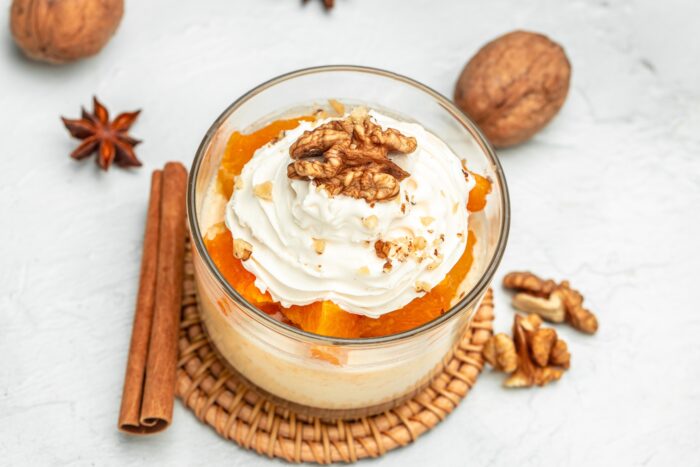By Kristin Feiler, culinary medicine dietitian at Rady Children’s Hospital Orange County
Healthy twists on Thanksgiving favorites that nourish and delight
November is a season of gratitude, gathering, and good food. It’s also a perfect time to show families that traditional comfort meals can be both nourishing and delicious. With a few smart swaps and colorful ingredients, holiday dishes can support gut health, immunity, and overall wellness without sacrificing flavor or fun.
As the weather cools and cold season begins, these recipes and tips blend the warmth of Thanksgiving with immune-boosting ingredients to keep your family healthy all month long.
1. Pumpkin yogurt parfaits: a sweet, gut-friendly swap
Instead of heavy pumpkin pie, layer dairy-free vanilla yogurt, pumpkin puree and a sprinkle of granola or crushed gluten-free graham crackers. This allergen-friendly dessert offers probiotics for digestive balance and beta-carotene for immune support. Pumpkin’s natural sweetness pairs perfectly with warm spices like cinnamon and nutmeg, making it a kid-approved treat.
Nutrition note: Pumpkin is rich in vitamin A, which helps support vision and immune defense, while yogurt provides probiotics for a healthy gut microbiome, according to the National Institutes of Health and Harvard Health.

2. Rainbow veggie tray: eat with your eyes
Brightly colored roasted vegetables turn an ordinary side dish into an edible rainbow. Try red peppers, orange carrots, yellow squash, green beans, and purple cauliflower. Roasting enhances sweetness, reduces bitterness, and makes veggies more appealing to kids.
GI-friendly recipe: rainbow veggie tray
- Chop assorted vegetables (red peppers, carrots, zucchini, purple cauliflower).
- Toss with olive oil, salt, and pepper.
- Roast at 400°F for 20–25 minutes, until tender.
- Serve warm for a festive, colorful side.
Nutrition note: Eating the rainbow provides a wide range of antioxidants and phytonutrients that help reduce inflammation and protect against illness, according to USDA MyPlate.

3. Gluten-free stuffing: allergy-inclusive comfort
Traditional stuffing can easily be adapted for gluten-sensitive families. Use gluten-free bread cubes, vegetable broth, and herbs like sage and thyme. Mix in diced celery, carrots, and mushrooms for extra fiber and flavor.
Nutrition note: A fiber-rich stuffing promotes gut motility and may help stabilize blood sugars, especially when paired with lean protein or healthy fats, according to Nutrition Reviews.
4. Carrot ginger soup: immune-boosting warmth
This cozy soup is perfect for post-holiday recovery.
Ingredients:
- 2 cups chopped carrots
- 1 Tbsp olive oil
- 1 tsp grated fresh ginger
- 2 cups low-sodium vegetable broth
Directions:
Sauté carrots and ginger in olive oil, add broth, and simmer until soft. Blend until smooth.
Nutrition note: Carrots provide beta-carotene, converted into vitamin A for immune and skin health. Ginger offers anti-inflammatory and antimicrobial benefits that can help reduce cold symptoms, according to the Journal of Medicinal Food and the National Institutes of Health.

5. Citrus and walnut snacks: simple seasonal boosters
Snack smart between meals with orange slices, tangerines or walnuts. Citrus fruits are packed with vitamin C to strengthen immune defenses, while walnuts provide omega-3 fatty acids that support both brain and immune function, according to Nutrients and Harvard T.H. Chan School of Public Health.
Try adding crushed walnuts and orange zest to oatmeal or yogurt for a cozy, nutrient-packed breakfast.

Healthy twists on Thanksgiving favorites for mindful, nourishing meals
Thanksgiving is more than a single meal; it’s a chance to nourish the body and soul. By choosing colorful, gut-friendly, and immune-supportive foods, families can enjoy the comfort of tradition with a healthy twist.
This season let’s celebrate gratitude through mindful eating: dishes that bring joy, connection, and wellness to every table.
Learn more about our integrative health and culinary medicine program
We are leading the way in pediatric integrative health — including culinary medicine — to advance healing, wellness, and nutrition-based therapies through clinical excellence, research, and education.





